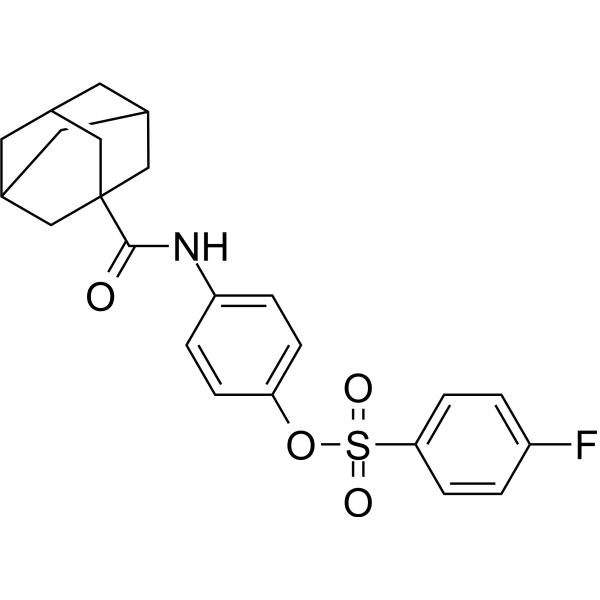Physicochemical Properties
| Molecular Formula | C23H24FNO4S |
| Molecular Weight | 429.504368782043 |
| Exact Mass | 429.141 |
| CAS # | 2883495-39-2 |
| PubChem CID | 155814656 |
| Appearance | White to off-white solid powder |
| LogP | 4.9 |
| Hydrogen Bond Donor Count | 1 |
| Hydrogen Bond Acceptor Count | 5 |
| Rotatable Bond Count | 5 |
| Heavy Atom Count | 30 |
| Complexity | 706 |
| Defined Atom Stereocenter Count | 0 |
| InChi Key | LLXLLGJJXOHBLG-UHFFFAOYSA-N |
| InChi Code | InChI=1S/C23H24FNO4S/c24-18-1-7-21(8-2-18)30(27,28)29-20-5-3-19(4-6-20)25-22(26)23-12-15-9-16(13-23)11-17(10-15)14-23/h1-8,15-17H,9-14H2,(H,25,26) |
| Chemical Name | [4-(adamantane-1-carbonylamino)phenyl] 4-fluorobenzenesulfonate |
| HS Tariff Code | 2934.99.9001 |
| Storage |
Powder-20°C 3 years 4°C 2 years In solvent -80°C 6 months -20°C 1 month |
| Shipping Condition | Room temperature (This product is stable at ambient temperature for a few days during ordinary shipping and time spent in Customs) |
Biological Activity
| Targets | CA Ⅸ 0.33 μM (IC50) CA XII 0.68 μM (IC50) NPP1 1.13 μM (IC50) NPP2 1.07 μM (IC50) NPP3 0.74 μM (IC50) |
| ln Vitro | Compound 1i (Enpp/Carbonic anhydrase-IN-2) (0-100 µM) inhibits the growth of some cancer cells with IC50s of 0.58, 0.58, 0.63, 0.42, 0.20, 0.72, 0.41, 0.76, 0.94, 0.28, 0.49, 0.59, 0.83 µM for K-562, COLO 205, HCT-116, HCT-15, HT29, KM12, SW-620, SF-539, NCI/ADR-RES, A498, PC-3, MCF7, and T-47D cells, respectively[1]. Normal skin fibroblast cells (F180) and normal breast epithelial cells (HME1) exhibit minimal cytotoxicity when exposed to Enpp/Carbonic anhydrase-IN-2 (0-2 µM), with IC50s of > 50 μM[1]. A dose-dependent mechanism of apoptosis induction is shown in K-562 cells by Enpp/ Carbonic anhydrase-IN-2 (0.58, 1.16 µM)[1]. |
| Cell Assay |
Cell Proliferation Assay[1] Cell Types: K-562, COLO 205, HCT-116, HCT-15, HT29, KM12, SW-620, SF-539, NCI/ADR-RES, A498, PC-3, MCF7, T-47D cells Tested Concentrations: 0-100 µM Incubation Duration: Experimental Results: Inhibited the cell growth with IC50s of 0.58, 0.58, 0.63, 0.42, 0.20, 0.72, 0.41, 0.76, 0.94, 0.28, 0.49, 0.59, 0.83 µM for K-562, COLO 205, HCT-116, HCT-15, HT29, KM12, SW-620, SF-539, NCI/ADR-RES, A498, PC-3, MCF7, T-47D cells, respectively. Apoptosis Analysis[1] Cell Types: K-562 cells Tested Concentrations: 0.58, 1.16 µM Incubation Duration: Experimental Results: Induced apoptosis in a dose-dependent manner. |
| References |
[1]. Design and synthesis of new adamantyl derivatives as promising antiproliferative agents. European Journal of Medicinal Chemistry, 2022. |
Solubility Data
| Solubility (In Vitro) | DMSO : 100 mg/mL (232.83 mM) |
| Solubility (In Vivo) |
Solubility in Formulation 1: ≥ 2.5 mg/mL (5.82 mM) (saturation unknown) in 10% DMSO + 90% Corn Oil (add these co-solvents sequentially from left to right, and one by one), clear solution. For example, if 1 mL of working solution is to be prepared, you can add 100 μL of 25.0 mg/mL clear DMSO stock solution to 900 μL of corn oil and mix evenly. (Please use freshly prepared in vivo formulations for optimal results.) |
| Preparing Stock Solutions | 1 mg | 5 mg | 10 mg | |
| 1 mM | 2.3283 mL | 11.6414 mL | 23.2829 mL | |
| 5 mM | 0.4657 mL | 2.3283 mL | 4.6566 mL | |
| 10 mM | 0.2328 mL | 1.1641 mL | 2.3283 mL |
